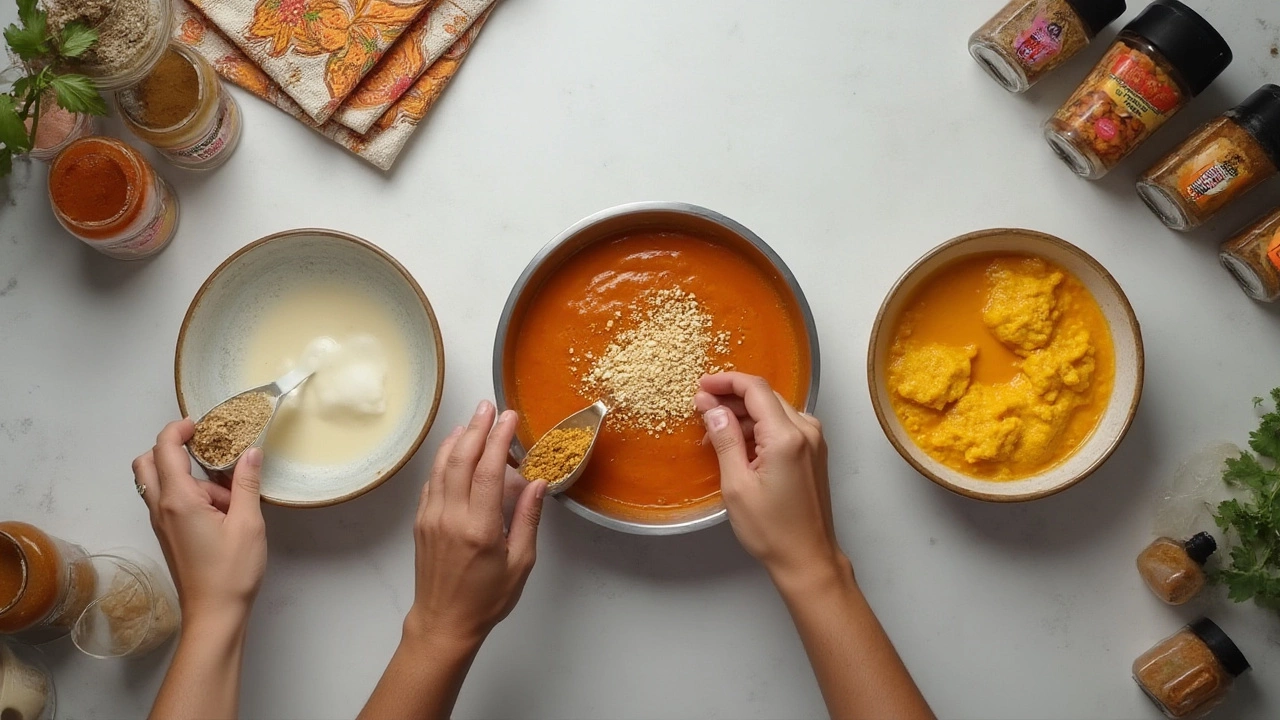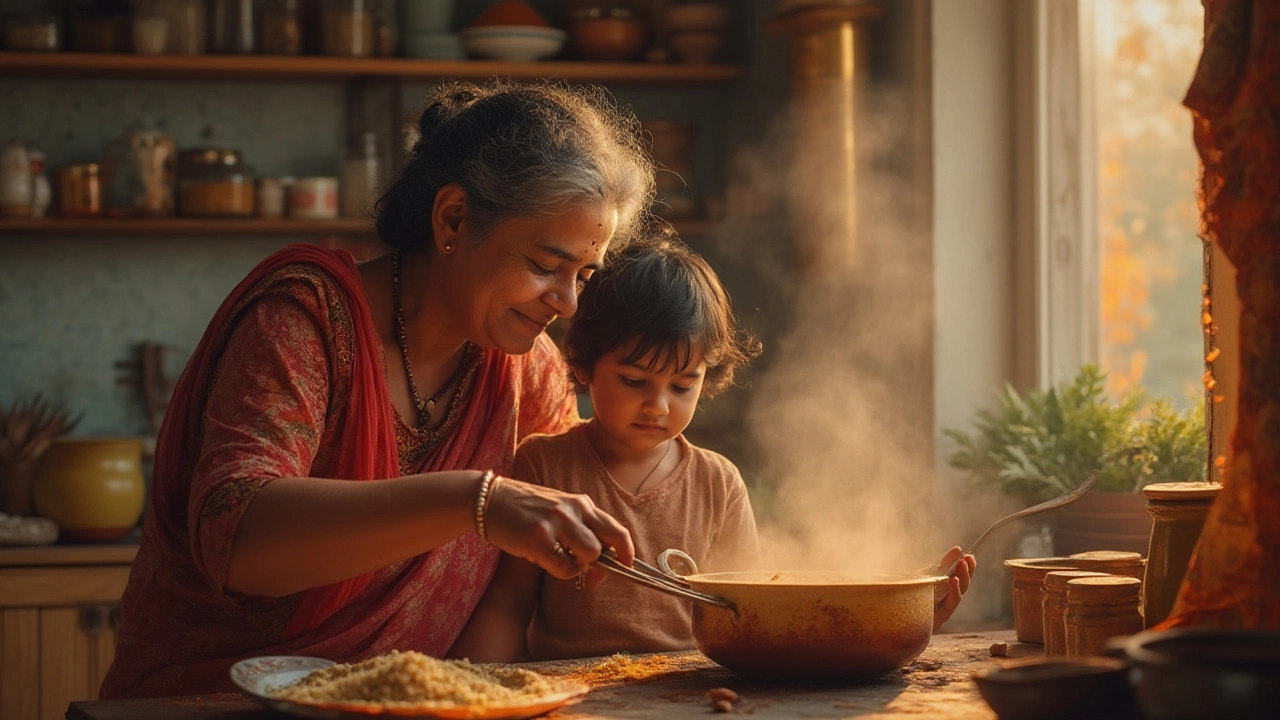Ever had a curry that looked more like soup than a luscious, glossy sauce? Nobody wakes up craving watery chicken tikka or a dal that runs off your plate. The gold standard for Indian curries is that mouth-coating, creamy consistency that makes you want to mop your plate clean with naan. But sometimes, even after following a recipe, the sauce just doesn’t reduce or come together the way you want. And that’s a letdown for anyone who spent an hour chopping, frying, and stirring in the kitchen. So what really makes a curry thick and rich? It’s not magic and it doesn’t always mean adding cream. It’s about understanding why sauces get too thin in the first place, and knowing a few tricks to fix it—right in your own kitchen, with things you already have.
Why Does Curry Turn Out Watery?
Most people think thickening curry is all about dumping extra spice or boiling it forever. The truth is, several things can make a curry watery. Sometimes, it’s the tomatoes letting out their juice or maybe the veggies lost their structure while cooking. Other times, there’s just too much water, thinking thinner sauce will taste lighter (it won’t). Even your choice of meat can sneak in more liquid—especially if it’s frozen chicken. Let’s not forget, onions are a staple in Indian curries and happen to be 89% water. When you fry onions until golden or brown, they not only develop flavor, they lose a ton of moisture. So if you rush this step, you’ll get more water bubbling in your pot later.
The way we tend to cook rice and rotis on the side, curries can get diluted by the temptation to save time or use shortcuts like pressure cookers. Quick-cook methods may shave minutes off dinner, but they leave curries runny. And have you tried using low-fat dairy instead of cream or coconut? The sauce just refuses to cling. There are numbers behind all this too—studies have shown that, on average, gravied Indian dishes lose only 15-20% of their water in 30 minutes of active open-lid simmering. Patience really pays when you’re after that thick, restaurant-style consistency.
Classic Indian Ways to Thicken Curry
Traditional Indian kitchens have a whole bag of tricks, most dating back hundreds of years. One of the oldest? Frying your onion-tomato-spice masala until it leaves oil (what grandma calls “bhuno” in Hindi). You want that masala glossy and thick before adding water or stock. And speaking of stock—using less of it early on gives you total control over sauce thickness. Here are some classic options every Indian cook knows about:
- Besan (Gram Flour): A tablespoon, fried in oil or ghee, goes a long way to thicken and add a nutty note. Mix it into your masala before adding liquids.
- Ground Cashew Paste: Soak and blend cashews, then add them for both richness and thickness. This is a staple in Shahi Paneer and many Mughlai-style dishes.
- Cook-and-Reduce: Simmer the curry uncovered. The key is low heat and time; you don’t want to burn the bottom, just reduce gently until the sauce thickens and darkens.
- Potatoes: Diced, boiled potatoes absorb excess liquid and break down to give a thicker body. This is a sneaky trick for vegetarian curries especially.
- Coconut Milk or Cream: Coconut gives a rich mouthfeel and is prized in southern Indian curries like Kerala’s fish molee or Chettinad chicken. Add at the end, simmer gently or it can split.
Every family has their pet thickener, sometimes even a handful of soaked bread or a scoop of leftover dal mashed in. The best part? These methods don’t just thicken; they add depth in flavor, too.
Modern Shortcuts: Pantry Fixes and Emergency Tricks
Let’s be honest, not everyone has time for old-school methods every night. That’s where pantry staples become your best friends. Had a day where your curry isn’t thickening fast enough before guests arrive? Here are quick solutions that won't scream 'hack job' to anyone tasting:
- Cornstarch Slurry: Mix a tablespoon of cornstarch with cold water, whisk until smooth, then slowly stir into your bubbling curry. It thickens fast, almost instantly, but doesn’t add much flavor—good for emergencies.
- Instant Mashed Potato Flakes: Hard to believe but works like a charm. Sprinkle flakes a little at a time, stir, and watch it soak up extra liquid. Especially helpful in tomato-heavy curries.
- Almond Meal or Peanut Butter: Almond and peanuts both show up in royal Indian dishes. Almond meal gives a subtle flavor, peanut butter adds both thickness and a unique taste, great in West Indian peanut-based curries.
- Thick Greek Yogurt: Adds tang and creaminess, but add it at the end and stir constantly to prevent curdling. Avoid non-fat yogurt as it may split or fail to add enough body.
- Rice Flour: Dissolve a teaspoon in water, add to simmering curry, and stir like mad to avoid lumps. This is common in Tamil cooking.
Newer cooking gadgets can help, too. An immersion blender can break down lingering veggies or legumes until silky—just blitz a few ladles right in the pot. Some home chefs even swear by popping curry into a hot oven (uncovered, shallow pan) for 15 minutes to help the liquid cook off without burning.

Choosing the Right Method for Your Curry
So all these options sound handy, but which thickener fits which curry? Not every method suits every style. If you’re making a classic butter chicken, a handful of cashews or a dollop of cream is more at home than instant mash. Trying to thicken a lentil-based dal? Mash some of the lentils with a back of your spoon against the pot. For vindaloo or sambar, stick with reducing over low heat—flour or cornstarch would ruin the finish.
- For North Indian curries (think paneer butter masala, dal makhani): Cashew paste, cream, or slow reduction works best.
- For South Indian dishes (like Chettinad chicken or coconut fish): Coconut milk and reducing with a bit of rice flour if needed.
- For quick, everyday vegetable curries: Mashed potatoes, besan, or blitzing a portion of veggies make it thick without extra fat.
- For tomato-heavy or tangy curries: Almond meal, instant potatoes, and time on the stove are your friends here.
| Thickener | Best For | Texture | Flavor Impact |
|---|---|---|---|
| Cashew Paste | Mughlai/North Indian | Creamy, rich | Mild, slightly sweet |
| Besan (Gram Flour) | Everyday veg, lentil curries | Thick, slightly grainy | Nutty, subtle |
| Coconut Milk | South Indian, Goan | Silky, smooth | Strong coconut |
| Potato (mashed/boiled) | Veg/vegan curries | Hearty, dense | Neutral, earthy |
| Cornstarch | Quick rescue | Glossy, clear | None |
| Instant Potato Flakes | Tomato gravies | Smooth, thick | Minimal |
Experimenting a bit helps you discover what matches your favorite recipes and fits your pantry.
Pro Tips for Consistently Perfect Curry Texture
If you want to avoid the last-minute scramble for thickeners, tweak your cooking routine from the start. Control your base: fry onions low and slow with a pinch of salt, drawing out water and building sweetness. Always let the tomato-spice paste cook down until oil seeps up, never add water too early. If using yogurt, whisk well before adding and temper it in slowly on low heat to stop curdling. Go easy on broth or water at the start; you can always add more if needed, but it’s much tougher to make up for excess later.
Using the right pan is a secret weapon. Heavy-bottomed kadhais hold steady heat and prevent scorching, so the reduction goes smooth and steady. Lids control evaporation, so simmer with the lid off if you want the sauce thicker. For stovetop reduction, a wide surface is better than deep pots—more liquid evaporates faster. Here’s a simple tip most restaurants use: add a spoonful of ghee or oil at the end. Oil rises and creates a fake gloss and gives the illusion of thicker sauce even when the body isn’t super dense.
One last thing—keep tasting. Texture is about more than looks or a fancy trick. Sometimes, a curry feels thick enough but needs an extra splash of salt, acid, or sugar to balance out the flavor. A squeeze of lemon or a half-teaspoon of sugar right at the end can bring back excitement to a dish that felt dull or flat after too much thickening or reduction. Good cooks trust their eyes, but great cooks trust their taste buds.
Common Curry Questions: Your Thickening Toolkit Q&A
Is there a single secret ingredient that works for every curry? No—and that’s honestly what keeps Indian cooking fun. Maybe you like yours gloopy enough to spoon, or just want it to cling to a bowl of rice. Try different base recipes and see what pairs best with your favorite dishes.
- Should I add flour directly? Never dump flour, besan, or cornstarch straight in—always mix with liquid first to avoid lumps.
- What if my curry splits after thickening? Whisk in a splash of warm milk or coconut milk on low heat, and keep stirring until smooth again.
- Does reducing make it salty? Yes, so adjust salt towards the end after thickening up the curry.
- How do restaurants make those super rich, thick curry gravies? Tons of cream, butter, cashews, and slow, slow reduction. They aren’t shy about fat for texture and flavor!
- Is it possible to thicken curry without adding calories? Yes. Try pureeing cooked veggies, mashing lentils, or just leaning hard into simmering uncovered to evaporate water. Also, using *small* amounts of thickeners keeps calorie counts reasonable.
The most important thing: don’t panic if your curry is runnier than you want. There are always at least half a dozen ways to rescue a sauce before dinner’s served. Pick your thickener based on what you love and what you have on hand, and pretty soon, the only thing running will be out-of-town guests, begging for your curry recipe!
